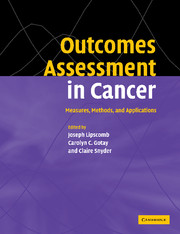Book contents
- Frontmatter
- Contents
- List of contributors
- Acknowledgments
- 1 Introduction to Outcomes Assessment in Cancer
- Health-related quality of life in cancer: general concepts and generic measures
- Assessing health-related quality of life during treatment
- Assessing health-related quality of life across the cancer continuum
- 10 Short-term outcomes of chemoprevention, genetic susceptibility testing, and screening interventions: What are they? How are they measured? When should they be measured?
- 11 Evaluating quality of life in cancer survivors
- 12 Assessing health-related quality of life at end of life
- Measuring the experience and needs of cancer patients and caregivers
- Methodological considerations in applications to cancer outcomes research
- Modern psychometric theory in cancer outcomes research
- Assessing the economic impact of cancer
- Research and policy implications
- Invited papers
- Index
- References
11 - Evaluating quality of life in cancer survivors
Published online by Cambridge University Press: 18 December 2009
- Frontmatter
- Contents
- List of contributors
- Acknowledgments
- 1 Introduction to Outcomes Assessment in Cancer
- Health-related quality of life in cancer: general concepts and generic measures
- Assessing health-related quality of life during treatment
- Assessing health-related quality of life across the cancer continuum
- 10 Short-term outcomes of chemoprevention, genetic susceptibility testing, and screening interventions: What are they? How are they measured? When should they be measured?
- 11 Evaluating quality of life in cancer survivors
- 12 Assessing health-related quality of life at end of life
- Measuring the experience and needs of cancer patients and caregivers
- Methodological considerations in applications to cancer outcomes research
- Modern psychometric theory in cancer outcomes research
- Assessing the economic impact of cancer
- Research and policy implications
- Invited papers
- Index
- References
Summary
Introduction
Currently, about 1.27 million new cancer cases are diagnosed each year, and 60% of all persons diagnosed with cancer are expected to be alive at least five years from the time of their diagnosis. Furthermore, the US death rate for all cancers combined has been declining since 1990, so annual growth in the number of individuals living with or beyond cancer is expected. Today, there are approximately 9 million cancer survivors in the US. Based upon 1996–1997 population estimates from the US Bureau of the Census, this represents approximately 3% of the entire population. Some of these individuals can be considered cured, while others still have evidence of active disease. Of the 9 million individuals living with a cancer history, over 1 million were diagnosed more than 20 years ago.
While these statistics indicate increased length of survival for individuals diagnosed with cancer, they give no indication of the quality of life:
Regardless of the type of cancer or the extent of survival, all persons diagnosed with cancer must manage the enduring and complex ways in which cancer transforms the self and everyday life.
(p. 239)Understanding how individuals who are cancer survivors manage the impact of cancer and experience the transformation of their lives is critical for health care professionals committed to assisting cancer patients and survivors in their recovery, for payers of health care, and for those engaged in policy regarding health insurance, employment, and disability-related rights of these many survivors.
- Type
- Chapter
- Information
- Outcomes Assessment in CancerMeasures, Methods and Applications, pp. 241 - 263Publisher: Cambridge University PressPrint publication year: 2004
References
- 4
- Cited by



